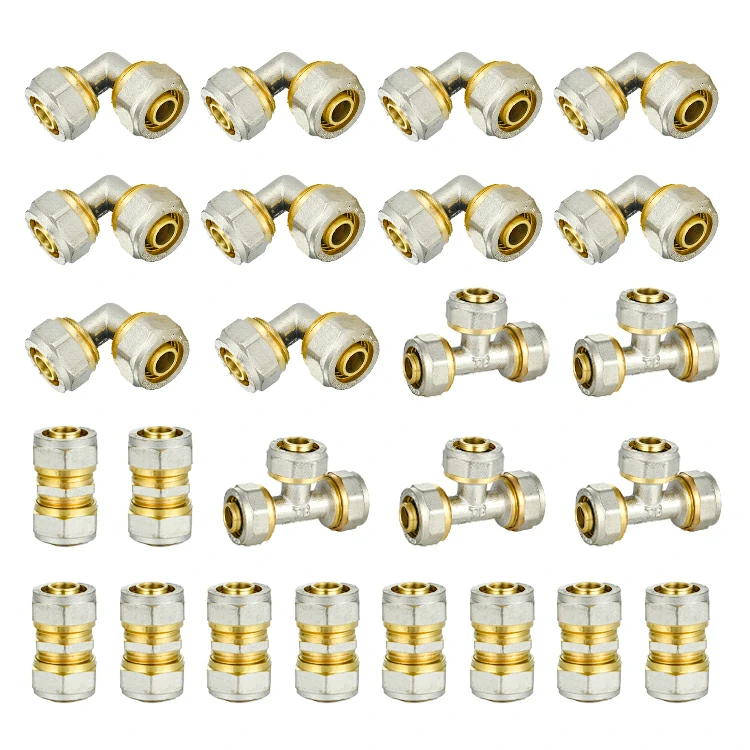PEX compression fittings are a type of plumbing fitting used to join PEX (cross-linked polyethylene) pipes together in a plumbing system. They work by using a compression nut and compression sleeve to secure the PEX pipe to the fitting body. The fitting creates a tight, leak-proof seal by compressing the sleeve around the pipe when the nut is tightened. These fittings are used for both water supply lines and heating systems, and they provide a durable, reliable connection without requiring heat, glue, or special tools beyond a basic wrench and pipe cutter.
The key feature of a PEX compression fitting is its mechanical sealing design, which makes it easy to install and ensures a long-lasting, leak-free connection. This is particularly beneficial in both residential and commercial plumbing applications.
Types
PEX compression fittings come in various configurations to accommodate different plumbing needs. Below are the most common types:
1.Socket
- Description: These fittings are used to connect two lengths of PEX pipe in a straight line. They typically feature a simple design with a compression nut and sleeve that grip both ends of the PEX pipe.
- Use Case: Ideal for joining two pieces of PEX pipe or extending existing piping systems.
- Example: Straight adapters or couplings.
2. Elbow
- Description: Elbow compression fittings allow for a 90-degree change in direction between two sections of PEX pipe. They come in both 90-degree and 45-degree angles.
- Use Case: Useful when you need to redirect the flow of water at a right angle (or other angle) in a plumbing system, such as turning a pipe around corners.
- Example: 90-degree elbow compression fitting.
3. Tee
- Description: Tee compression fittings have three ports—one inlet and two outlets—allowing you to split the water flow from one PEX pipe to two other pipes.
- Use Case: Used for branching off from an existing PEX line to create multiple pipe runs.
- Example: T-shaped compression fitting used in both hot and cold water lines.
4. Male and Female thread
- Description: These adapters allow you to connect PEX pipe to different types of pipe threads. Male adapters have external threads that screw into a fitting, while female adapters have internal threads to receive male-threaded fittings.
- Use Case: Ideal when transitioning from PEX pipe to another type of material, like copper or threaded steel pipe.
- Example: Male adapter for PEX to thread onto a standard threaded fitting.
5. Caps and Plugs
- Description: Caps and plugs are used to seal the end of a PEX pipe or fitting. Caps are typically used to close off the end of a pipe, while plugs can seal off a fitting or valve port.
- Use Case: Useful for terminating pipe runs or closing off unused ports in a system.
- Example: Compression cap fitting.
6. Union Compression Fittings
- Description: Union compression fittings are similar to straight compression fittings but are designed to allow for easy disconnection and reconnection. The union design uses two compression nuts and a central coupling body, allowing the pipe to be removed and reinstalled without cutting the pipe.
- Use Case: Useful for systems that may need periodic maintenance or disassembly.
- Example: Union coupling for disconnection and reconnection of PEX piping.
7. Reducing Compression Fittings
- Description: Reducing compression fittings allow for transitioning between pipes of different sizes. They have a larger inlet for one size of pipe and a smaller outlet to accommodate a smaller pipe.
- Use Case: Ideal for systems that require a change in pipe size to match existing plumbing or to reduce flow in certain areas of the system.
- Example: Reducing couplings for PEX pipes of different diameters.
Materials
PEX compression fittings are typically made from one of the following materials:
- Brass: The most common material for compression fittings, brass is durable, corrosion-resistant, and has good strength to handle water pressure.
- Stainless Steel: Used for environments that require superior resistance to corrosion and high-pressure systems, stainless steel is more expensive but offers added durability.
- Nickel-Plated Brass: Brass fittings that are coated with a layer of nickel to provide extra protection against corrosion, commonly used in visible installations where aesthetics are a factor.
- Plastic (Polymer): Some compression fittings are made from durable plastic materials, providing a more lightweight, cost-effective option for low-pressure applications.
Advantages
- Easy Installation: They are simple to install with basic tools, requiring only a pipe cutter and wrench.
- Leak-Proof Connections: When installed correctly, PEX compression fittings provide a reliable, watertight seal.
- No Heat Required: Unlike soldering or gluing, compression fittings do not require heat, making them safer and quicker to install.
- Removable and Reusable: Compression fittings can be disassembled, making them ideal for temporary installations or repairs.
- Durable and Corrosion-Resistant: Compression fittings are typically made from corrosion-resistant materials like brass or stainless steel, ensuring long-term reliability.
Conclusion
PEX compression fittings are a flexible and effective way to join PEX pipes in a plumbing system. Available in various types—such as straight, elbow, tee, adapter, and union—they are designed to provide secure, leak-proof connections for a wide range of plumbing applications. Their simple installation process, combined with the ability to handle both high and low-pressure systems, makes them a popular choice in residential and commercial plumbing projects.
Standard:ASTM F1974,ASTM F1281,CSA B137,DIN 16836,GB18997,ISO 21003.It is their standard,so it product is safety and Professional.
View more:https://www.ifanfittings.com/


